Alessandro Spugna is a 49-year-old Italian head coach, leading Serie A Women’s Roma at the moment.
He is considered one of the most impactful head coaches at the moment, and that’s exactly why this article will explore his value and contribution to Roma Women further.
Spugna started his coaching career back in 2002 when he worked with Torino’s youth before having another enriching experience with the youth from 2014 to 2018 at Juventus.
Afterwards, he started coaching the U19 Juventus Women before coaching Empoli Ladies and, lastly, Roma Women, the team with which he has made a big impact so far since they are leading Serie A Women by three points ahead of second-placed Juventus.At the same time, Spugna helped the Giallorosse achieve the UWCL’s knockout stage for the first time ever in their history.
It’s worth mentioning that the journey is yet to finish, and Roma could reach more advanced stages in this competition if they keep playing with the same organisation, efficiency, and determination.
In fact, Spugna’s Roma have enjoyed some great results this season, in particular after showing some impressive signs last season since they won the 2021–22 Coppa Italia as well as the 2022 Supercoppa Italiana by beating Juventus.
Let’s not forget that finishing the 2021–22 season in second place was the first big step towards actual European achievement.
It was not easy to succeed in finishing second despite the competition from Sassuolo, Inter, Milan, and Fiorentina during that season.
Yet, Spugna’s side proved their worth and value by finishing that season with solid results, only to consolidate them during this season with more outstanding ones so far.
In this tactical analysis and scout report, we will
analyse what characterises this Roma team and what helped them achieve their impressive results in Serie A Women andUWCL.
This cannot be done without understanding Spugna’s principles, philosophy of play, ideas and preferred tactics.
Alessandro Spugna Preferred formations and playing style
In terms of formations, Spugna is a head coach who doesn’t base his ideas on one specific system, as he prefers to adapt his systems to fit the types of players at his disposal.
Therefore, he often changes formations and doesn’t really rely on a single one.
He uses the 4-2-3-1, the 4-3-3, the 3-5-2, the 3-4-3 and more.
While using these formations, Spugna’s Roma relies mainly on short passing build-up from the back, which Manuela Giugliano often guides with the help of the back four, as you can see below.
If the team runs out of passing solutions, it resorts to long passing as a last choice against Valentina Giacinti, Sophie Roman Haug, or one of the two wingers.
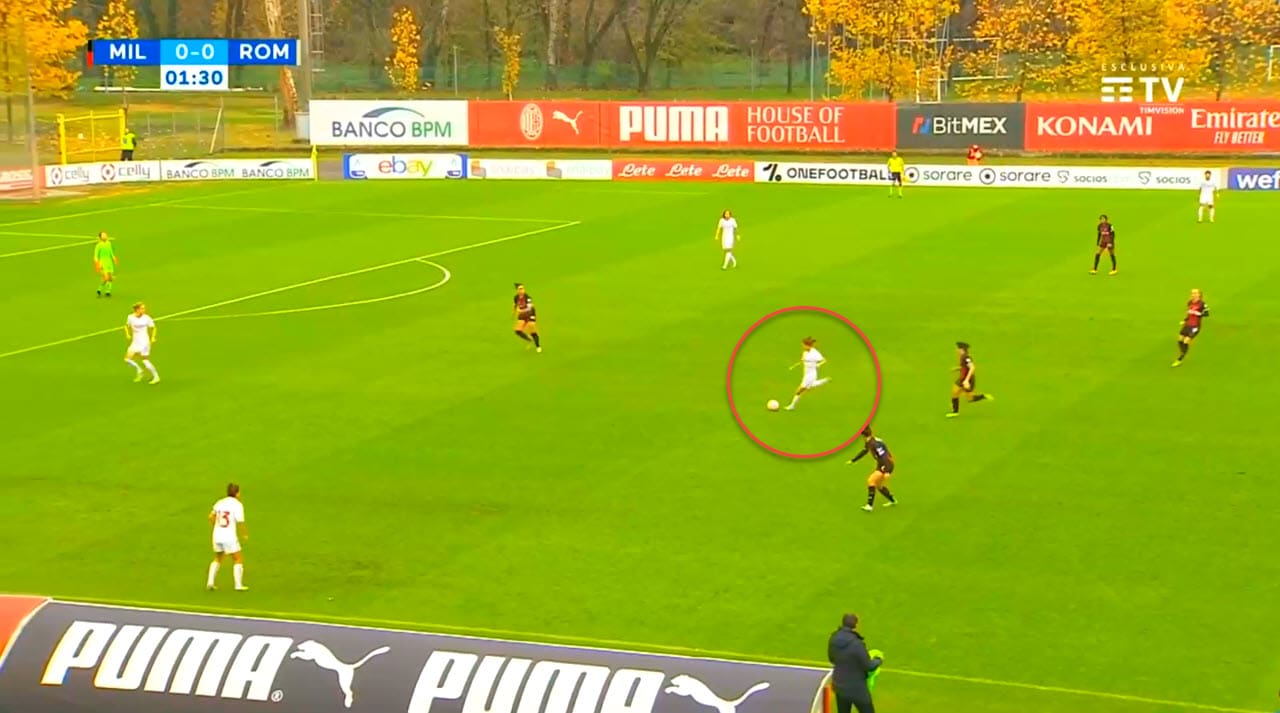
Spugna relies on some key players in order to ensure accuracy both in terms of playmaking and dribbling.
Some of these players include Manuela Giugliano, Emilie Haavi, Andressa Alves, Annamaria Serturini, Valentina Giacinti and Sophie Roman Haug.
In defence, Elena Linari, Elisa Bartoli and Wenninger represent the fundamental defensive players.
In terms of playing style, Spugna likes to develop talents and include them in his system while giving them the proper instructions to build and help the team in the necessary way.
His Roma is usually well-organised, attacks well and uses a lot of pressing in attack.
He relies heavily on both wings and prefers to have quality wingers with dribbling abilities and accurate crossing since his attacking plans rely on crossing and penetrations.
Alessandro Spugna Attacking plans
From an attacking perspective, the attacking players mentioned above represent the heart of the Roma build-up and attack.
With correct instructions from Spugna, they were able to become much more powerful as a team.
Spugna gave his players a lot of calculated freedom in the final third, which means that he helped them become more creative and, therefore, more dangerous in this area.
Even midfielders like Giugliano are making a significant attacking impact both in terms of playmaking and goalscoring.
For instance, in their match against Milan, Giugliano scored a header while coming from the back and kicking the ball when inside the box, surprising everyone, including her teammates, since she started running as soon as Haavi crossed the ball.
In fact, the action started with Haavi, who passed her opponent with great technique and crossed the ball with her left foot towards the box.
Inside the box, only Giacinti was standing while being marked, and no one expected to see Giugliano advance to make an impact on that cross, not only because she is not a tall player but also because she was playing as a defensive midfielder.
Such variation and creativity of ideas help Roma score goals when things seem too complicated.
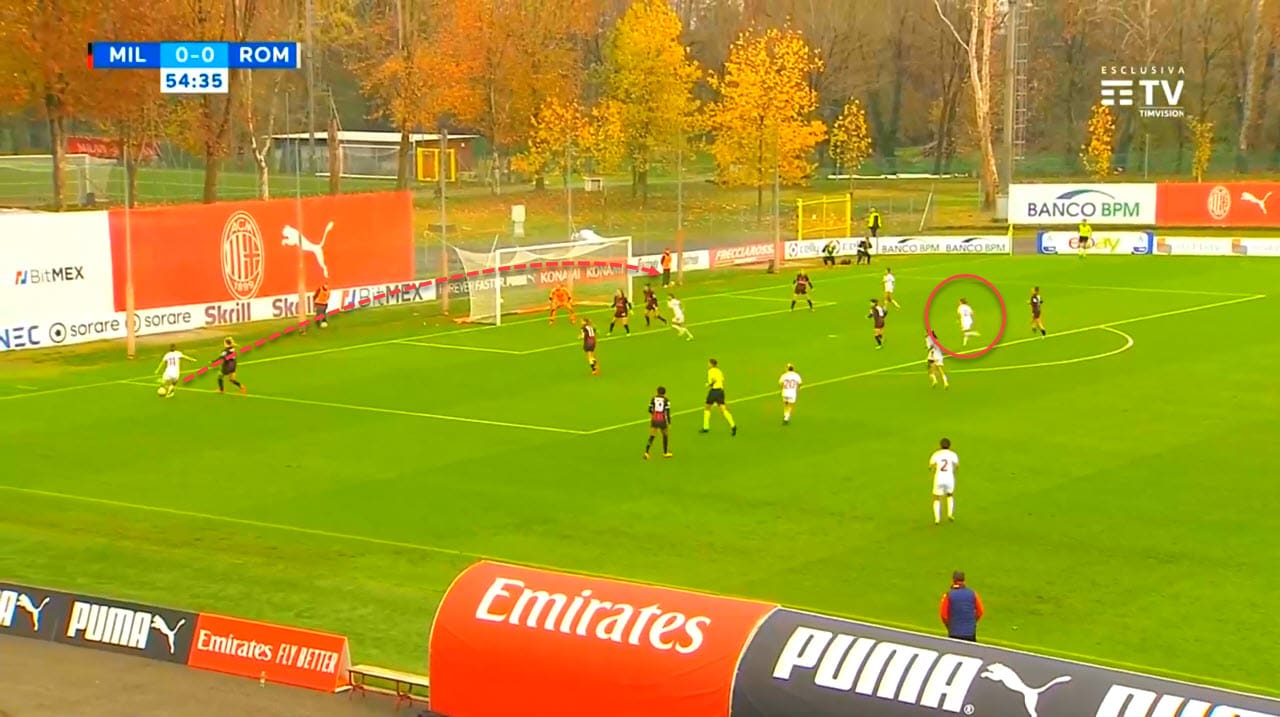
Moreover, this goal action occurred twice in the same match. The same player dribbled on the left wing before crossing with her left foot and getting the ball to Giugliano, who scored with a left-footed half-volley this time.
This tells us a lot about the improved finishing and playmaking quality this team developed under Spugna.
What has also improved and what Spugna pushes his players to do more often is shooting from distance.
The team scores more and more goals from a distance, and different players are actually capable of doing so from various positions.
Giugliano is one of the best in this regard but also Paloma Lázaro proved to be dangerous regarding this aspect.
The two players scored two excellent shots from a distance lately in the UWCL, and here is one of them.
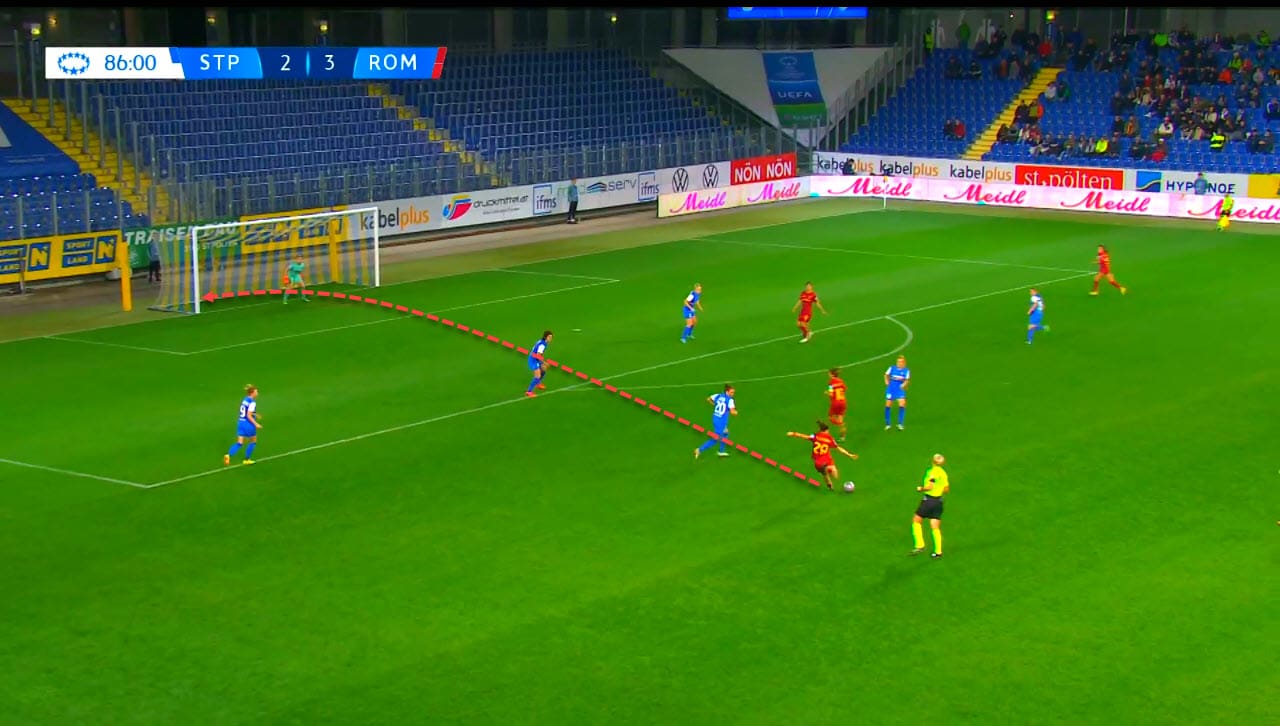
The diversity of attacks and the reliance on quality players in the right positions helped Spugna and Roma reach some great results so far.
The great run of form of players like Giugliano, Giacinti, Haavi, and others can only help the team become even more difficult to beat both in Serie A Women and in UWCL.
Nevertheless, Spugna will need to ensure his players don’t lose enthusiasm and become too relaxed during the rest of the season, which is going to be more crucial.
Alessandro Spugna Defensive tactics
From a defensive perspective, Roma are characterised by a solid defensive line which is usually formed of four players who are very good in duels and in closing down opponents.
Nevertheless, the team’s defensive performances are not always convincing and the efforts of Spugna are not always rewarded mainly due to recurrent positioning errors and individual marking mistakes.
Despite these risks, Spugna has had a very solid season with Roma, as his team conceded seven goals in 12 Serie A Women’s games.
When comparing Roma with the other Serie A teams, only Juventus come a bit close to them in this regard, and they conceded 12 goals in 12 games.
These statistics highlight the fact that Roma conceded very few goals in Serie A Women.
But at the same time, they concede more in the UWCL.
Therefore, Spugna will have to adapt his defensive strategy to the European playing style to cope with the powerful European teams’ attacks and avoid conceding numerous goals in important fixtures.
To do so, it will be essential to avoid leaving too much space between the left-backs and the two centre-backs in a way that allows the opposing players to penetrate without real problems either on the wings or between RB/LBs and CBs.
Roma conceded one of the goals against Sank Polten due to this exact space issue which allowed the opponents to find the necessary space for passing and shooting without real disturbance from the Giallorosse.
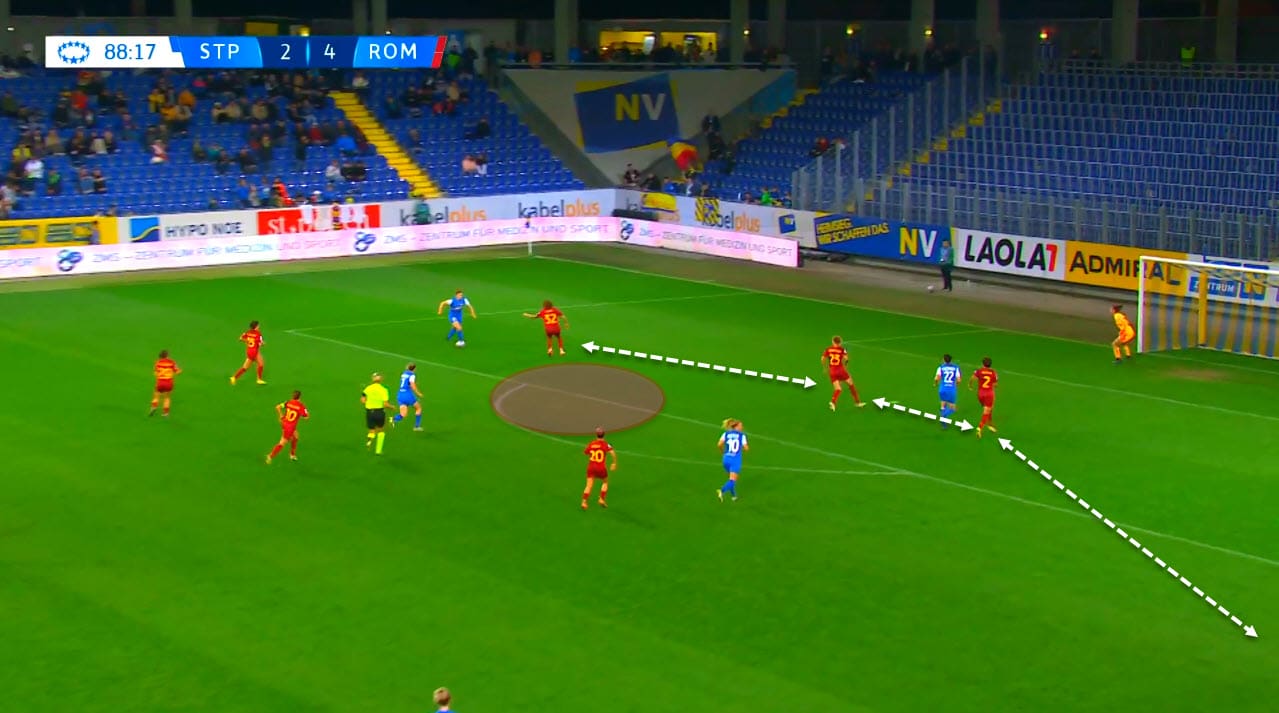
In addition, Spugna will have to work further on both flanks in terms of defensive duels to avoid letting opponents penetrate and reach the box quickly and without facing any obstacles.
The following example shows clearly how Roma’s left-back was not able to mark her direct opponent well and the latter surpassed her.
At that time, no other player covered for her or tried to prevent her penetration.
Instructing the close midfielder to always retreat on such occasions, cover for the left-back, and create numerical superiority can surely help the team avoid such dangerous actions and be more compact.
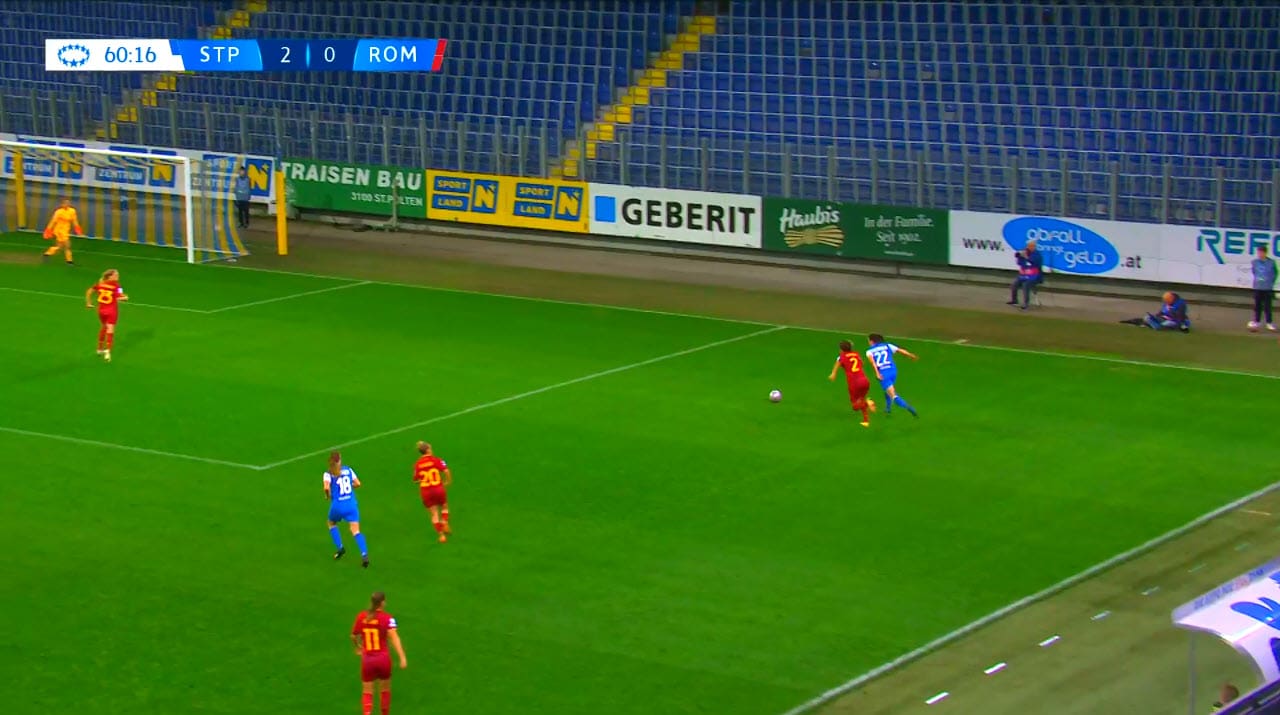
Overall, Roma’s defensive tactics are neither fantastic nor bad.
They are suitable for Serie A Women’s level but could be insufficient for the upcoming rounds of UWCL.
That’s why Spugna’s next challenge will be to ensure that his team’s defence remains compact even when playing against a potent attacking team.
Conclusion
Alessandro Spugna helped Roma reach some unexpected results during this season so far.
If the team keeps performing at the same level and commits fewer mistakes, Roma could lift the Serie A title, and why not reach a more advanced stage in the UWCL?
The biggest challenge for them will be their encounter with Juventus and the ability to keep winning games without dropping points in order to secure their top spot.
But in all cases, Spugna has already proven that he is an up-and-coming and talented head coach, and his journey at Roma would confirm this even further.





Comments